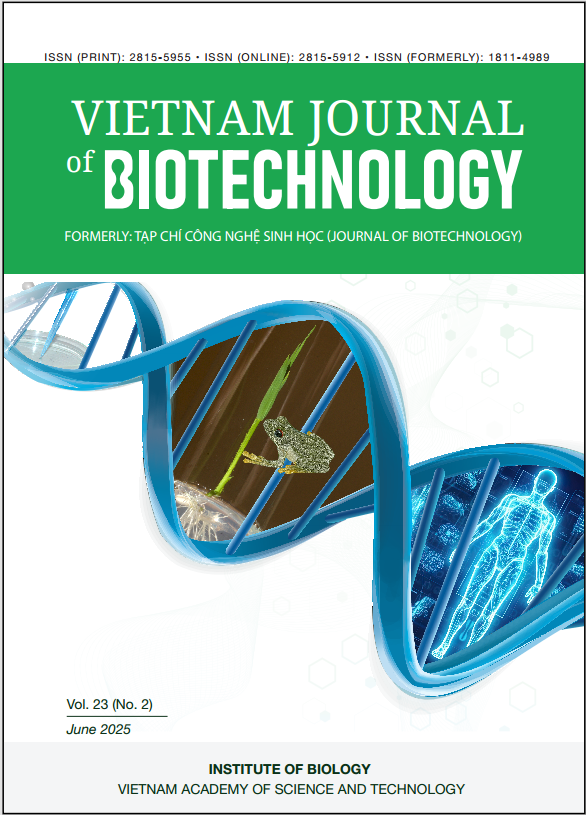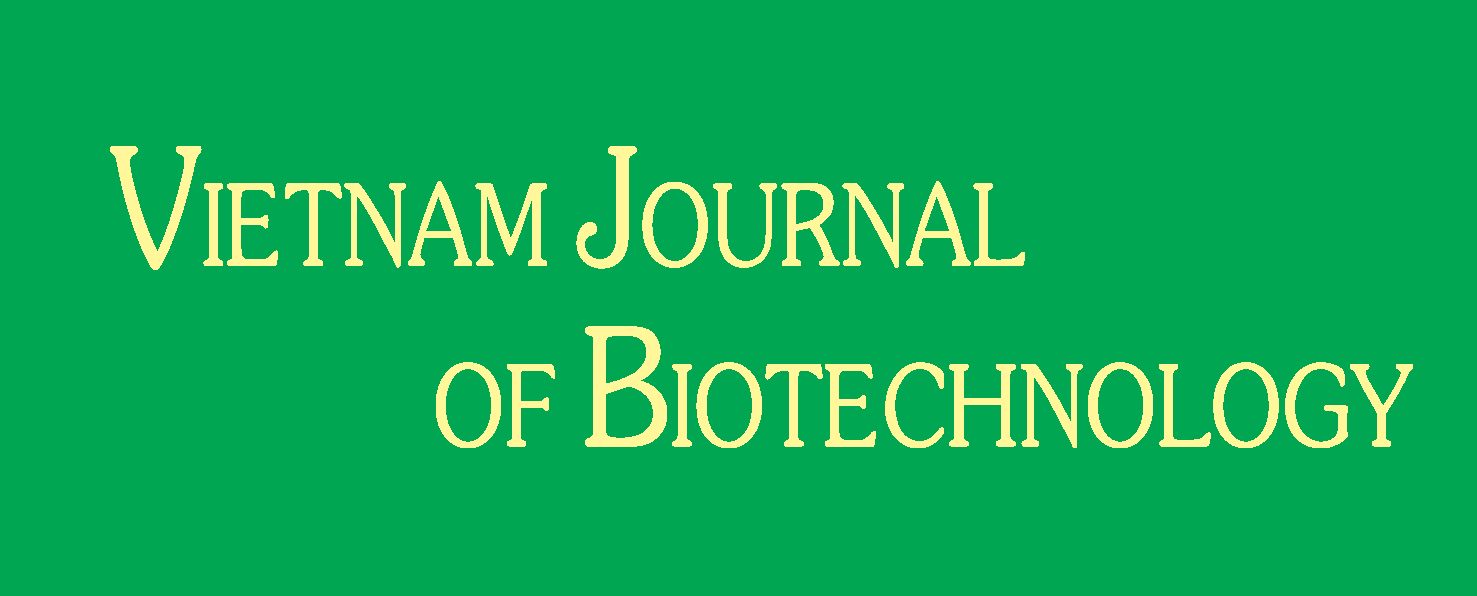Inhibition of avian influenza A virus H5N1 by using methylene blue with laser treatment in vitro
Author affiliations
DOI:
https://doi.org/10.15625/vjbt-22344Keywords:
laser, MDCK assay, methylene blue, ST-2009 virus, virus titerAbstract
The avian influenza virus H5N1 causes the death of millions of avians, including the risk of viral infection in humans. In photodynamic therapy, photosensitizers with light and molecular oxygen might result in the death of cells by generating cytotoxic molecules. Photosensitizers such as methylene blue and laser treatment have been demonstrated to have high efficacy against several types of viruses. The anti-H5N1 effects of several photosensitized compounds, such as methylene blue with laser treatment, are not known. We found that the titer of the ST-2009 virus was 10 × 107 pfu/mL via the MDCK plaque assay. Methylene blue treatment at 0.1 to 1.0 µM had safe effects on MDCK cells. In this study, we demonstrated that the titers of the ST-2009 virus were 3.9 log10 pfu/mL, 5.7 log10 pfu/mL and 6.8 log10 pfu/mL without the methylene blue treatment, but no ST-2009 virus titer was detected after treatment with 0.5 μM methylene blue. In addition, the survival of the ST-2009-infected MDCK cells was significantly greater when the cells were treated with 0.5 to 1.0 μM methylene blue in combination with a laser for 80 s at 16 J/cm2 than in the nontreated control. The survival rates of the MDCK cells were 98.1 ± 0.2 and 96.7 ± 0.4% when the laser treatment (80 s and 16 J/cm2) was combined with 0.5 and 1.0 μM methylene blue, respectively. In addition, without laser treatment or the addition of 0.5 or 1.0 μM methylene blue, the percentages of living cells significantly decreased to 8.3 ± 0.3 and 6.3 ± 0.2%, respectively. The survival of MDCK cells without the addition of methylene blue was 7.5 ± 0.4%, whereas that without laser treatment was 4.6 ± 0.5%. In summary, photosensitizers such as methylene blue with laser treatment can be suitable therapies for the inhibition of avian influenza A virus H5N1.
Downloads
References
Abe, H., and Wagner, S. J. (1995). Analysis of viral DNA, protein and envelope damage after methylene blue, phthalocyanine derivative or merocyanine 540 photosensitization. Photoche- mistry and Photobiology 61(4), 402-409. https://doi.org/10.1111/j.1751-1097.1995.tb08630.x
Baer, A., and Kehn-Hall, K. (2014). Viral concentration determination through plaque assays: using traditional and novel overlay systems. Journal of Visualized Experiments. 93: e52065. https://doi.org/10.3791/52065
Bouvier, N. M., and Palese, P. (2008). The biology of influenza viruses. Vaccine 26(4), D49-D53. https://doi.org/10.1016/j.vaccine.2008.07.039
Hoang, H. T. T., Nguyen, C. H., Nguyen, N. T. T., Pham, A. D., Nguyen, H. T. T., Le, T. H., et al. (2020). Immunization with the H5N1 recombinant vaccine candidate induces high protection in chickens against Vietnamese highly pathogenic avian influenza virus strains. Vaccines (Basel) 8(2), 159. https://doi.org/10.3390/vaccines8020159
Hooker, K. L., and Ganusov, V. V. (2021). Impact of oseltamivir treatment on influenza A and B virus dynamics in human volunteers. Frontiers in Microbiology 12: 631211. https://doi.org/10.3389/fmicb.2021.631211
Hung, H. C., Tseng, C. P., Yang, J. M., Ju, Y. W., Tseng, S. N., Chen, Y. F., et al. (2009). Aurintricarboxylic acid inhibits influenza virus neuraminidase. Antiviral Research 81(2), 123-131. https://doi.org/10.1016/j.antiviral.2008.10.006
Hussain, S., Miller, J. L., Harvey, D. J., Gu, Y., Rosenthal, P. B., Zitzmann, N., et al. (2015). Strain-specific antiviral activity of iminosugars against human influenza A viruses. The Journal of Antimicrobial Chemotherapy 70(1), 136-152. https://doi.org/10.1093/jac/dku349
Lim, M. E., Lee, Y. L., Zhang, Y., and Chu, J. J. (2012). Photodynamic inactivation of viruses using upconversion nanoparticles. Biomaterials 33(6), 1912-1920. https://doi.org/10.1016/j.biomaterials.2011.11.033
Luz, J. R. D., Barbosa, E. A., Do Nascimento, T. E. S., de Rezende, A. A., Ururahy, M. A. G, Brito, A. da. S. et al. (2022). Chemical characterization of flowers and leaf extracts obtained from Turnera subulata and their immunomodulatory effect on LPS-activated RAW 264.7 macrophages. Molecules 27. 1084. https://doi.org/10.3390/molecules27031084
Marotti, J., Sperandio, F. F., Fregnani, E. R., Aranha, A.C., de Freitas, P. M., Eduardo Cde, P. (2010). High-intensity laser and photodynamic therapy as a treatment for recurrent herpes labialis. Photomedicine and Laser Surgery 28(3), 439-444. https://doi.org/10.1089/pho.2009.25
Nguyen, T. N., Nguyen, H. C., Chu, H. H., Do, T. R., Nguyen, T. B. N., and Le, T. H. (2022). Evolutionary characterization of clades 2.3.4.4 H5N6 and 2.3.2.1c H5N1 HPAI viruses in Vietnam (2013–2019) revealed distinct reassortants from distant spillovers. Vietnam Journal of Biotechnology 20(2), 231-243. https://doi.org/10.15625/1811-4989/15325
Siegers, J. Y., van de Bildt, M. W. G., Lin, Z., Leijten, L. M., Lavrijssen, R. A. M., Bestebroer, T., et al. (2019). Viral factors important for efficient replication of influenza A viruses in cells of the central nervous system. Journal of Virology 93(11): e02273-18. https://doi.org/10.1128/JVI.02273-18
Svyatchenko, V. A., Nikonov, S. D., Mayorov, A. P., Gelfond, M. L, and Loktev, V. B. (2021). Antiviral photodynamic therapy: Inactivation and inhibition of SARS-CoV-2 in vitro using methylene blue and Radachlorin. Photodiagnosis and Photodynamic Therapy 33: 102112. https://doi.org/10.1016/j.pdpdt.2020.102112
Vzorov, A. N., Dixon, D. W., Trommel, J. S., Marzilli, L. G., and Compans, R. W. (2002). Inactivation of human immunodeficiency virus type 1 by porphyrins. Antimicrobial Agents and Chemotherapy 46(12), 3917-3925. https://doi.org/10.1128/AAC.46.12.3917-3925.2002
Wainwright, M. (2000). Methylene blue derivatives--suitable photoantimicrobials for blood product disinfection? International Journal of Antimicrobial Agents 16(4), 381-394. https://doi.org/10.1016/s0924-8579(00)00207-7
Wei, L., Ma, Y., Ren, Y., Lu, S., Xiao, X., Luo, S., et al. (2024) Methylene blue has strong extracellular virucidal activity against a SARS-CoV-2-related pangolin coronavirus with no intracellular or in vivo efficacy. Pathogens (Basel, Switzerland) 13(11), 958. https://doi.org/10.3390/pathogens13110958
https://www.who.int/emergencies/disease-outbreak-news/item/2024-DON511
Thu Hang, N. T., Thu Hang, H. T., Chi, N. H., Trang, V. H., Ha, C. H., & Nam, N. T. (2018). Designing and cloning na gene of influenza A/H5N1 virus into PHW2000 vector for preparation of a candidate vaccine masterseed strain. Vietnam Journal of Biotechnology, 16(2), 369–376. https://doi.org/10.15625/1811-4989/16/2/13450







